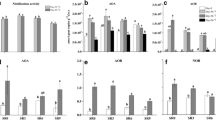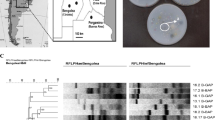Abstract
The seasonal fluctuations in the concentration of cultured denitrifying and N2-fixing bacteria were followed in an ammonium fertilised and a control soil of a Norway spruce forest near Villingen/Black Forest from December 1994 to August 1998. The horizontal distribution of bacteria in three layers was determined by the MPN-method and by molecular probing (colony hybridisation) using specific 0.4–0.7 kb DNA probes for denitrification steps (narG, nirS, nirK and nosZ) and for N2-fixation (nifH). The data showed that highest bacterial counts and higher numbers of denitrifying and N2-fixing bacteria were generally detectable in the upper (= 5 cm) soil layer and that their amount decreased with soil depth. The concentration of these cultured bacteria showed seasonal fluctuations with highest numbers in autumn/winter/early spring and with low counts in summer. Denitrifying and N2-fixing bacteria amounted to less than 10% of the total number of cultured bacteria determined by the MPN-method. Fertilisation with ammonium did not cause a shift in the population of these bacteria. These findings were corroborated by hybridisation experiments with genomic DNA isolated from the different layers. Strongest DNA–DNA hybridisation band intensities were obtained in the upper soil layer and their intensities decreased with soil depth. Soil samples from Villingen assayed in the laboratory produced N2O (in dependence of nitrate and C2H2 added to the vessels) and utilised this gas with higher activities in the assays with the fertilised soil. It is concluded that molecular techniques can successfully be applied for assessing seasonal fluctuations of bacterial populations in soil. Relative abundance of denitrifying and N2-fixing bacteria can be determined from experiments with DNA isolated from soils. Attempts to transform these results to the total population of soil bacteria on a single cell basis are faced with many uncertainties.
Similar content being viewed by others
References
Alexander M 1982 Most probable number method for microbial populations. In: Methods of Soil Analysis, Eds. AL Page, RH Miller and DH Keeney. pp 815–820. Agronomy Monograph no. 9 (2nd edn.). ASA-SSSA, Madison, Wi 53711, USA.
Amann R, Glöckner F-O and Neef A 1997 Modern methods in subsurface microbiology: In situ identification of micro-organisms with nucleic acid probes. FEMS Microbiol. Rev. 20, 191–200.
Amann R, Ludwig W and Schleifer K H 1995 Phylogenetic identification and in situ detection of individual cells without cultivation. Microbiol. Rev. 59, 143–169.
Borneman J, Skroch P W, O'sullivan K M, Palus J A, Rumjanek N G, Jansen J I, Nienhuis J and Triplett E W 1996 Molecular diversity of an agricultural soil in Wisconsin. App. Environm. Microbiol. 62, 1935–1943.
Braker G, Fesefeldt A and Witzel K-P 1998 Development of PCR primer systems for amplification of nitrite reductase genes (nirK and nirS) to detect denitrifying bacteria in environmental samples. Appl. Environ. Microbiol. 64, 3769–3725.
Bremner J M, Robbins S G and Blackmer A M 1980 Seasonal variability in emission of nitrous oxide from soil. Geophys. Res. Lett. 7, 641–644.
Brosius J, Dull T J, Sleeter D D and Noller H F 1981 Gene organization and primary structure of a ribosomal RNA operon from Escherichia coli. J. Mol. Biol. 148, 107–127.
Cataldo D A, Haroon M, Schrader L E and Youngs V L 1975 Rapid colorimetric determination of nitrate in plant tissue by nitration of salicylic acid. Comm. Soil Sci. Plant An. 6, 71–80.
Coyne M S, Arunakumari A, Averill B A and Tiedje M A 1989 Immunological identification and distribution of dissimilatory heme cd 1 and non-heme copper nitrite reductases in denitrifying bacteria. Appl. Environ. Microbiol. 55, 2924–1931.
Daum M, Zimmer W, Papen H, Kloos K and Nawrath K, Bothe H 1998 Physiological and molecular biological characterization of ammonia oxidation of the heterotrophic nitrifier Pseudomonas putida. Current Microbiol. 37, 281–288.
De Zamaroczy M, Delorme F and Elmerich C 1989 Regulation of transcription and promoter mapping of the structural genes for nitrogenase (nifHDK) of Azospirillum brasilense Sp7. Mol. Gen. Genet. 220, 88–94.
Feger, K H and Raspe S 1992 Ernährungszustand von Fichtennadeln und –wurzeln in Abhängigkeit vom Nährstoffangebot im Boden. Forstwiss. Centralblatt 111, 73–86.
Felske A, Wolterink A, Van Lis R, De Vos W M and Akkermans A D L 1999 Searching for predominant soil bacteria: 16S-rDNA cloning versus strain cultivation. FEMS Microbiol. Ecol. 30, 137–145.
Fesefeldt A, Kloos K, Bothe H, Lemmer H and Gliesche C G 1998 Distribution of denitrification and nitrogen fixation genes in Hyphomicrobium spp. and other budding bacteria. Can. J. Microbiol. 44, 181–186.
Frostegard A, Courtois S, Ramisse V, Clerc S, Bernillon D, Le Gall F, Jeannin P, Nesme X and Simonet P 1999 Quantification of bias related to the extraction of DNA directly from soils. Appl. Environm. Microbiol. 65, 5409–5420.
Fuhrman J A, Comeau D E, Hagström A and Chan A M 1988 Extraction from natural planktonic micro-organisms of DNA suitable for molecular biological studies. Appl. Environ. Microbiol. 54, 1426–1429.
Grunstein M and Hogness D S 1975 Colony hybridisation: A method for the isolation of cloned DNAs that contain a specific gene. Proc. Natl. Acad. Sci. USA 72, 3961–3965.
Hodson R E, Dustman W A, Garg R and Moran M A 1995 In situ PCR for visualization of microscale distribution of specific genes and gene products in prokaryotic communities. Appl. Environ. Microbiol. 61, 4074–4082.
Joergensen K S 1989 Annual pattern of denitrification and nitrate ammonification in estuarine sediment. Appl. Environ. Microbiol. 55, 1841–1847.
Kloos K, Hüsgen U and Bothe H 1998 DNA-probing for genes coding for denitrification, N2-fixation and nitrification in bacteria isolated from different soils. Z. Naturforsch. 53c, 69–81.
Kloos K, Fesefeldt A, Gliesche C G and Bothe H 1995 DNA-probing indicates the occurrence of denitrifying and nitrogen fixation genes in Hyphomicrobium. Distribution of denitrifying and nitrogen fixing isolates in a sewage treatment plant. FEMS Microbiol. Ecol. 18, 205–213.
Knowles R 1982 Denitrification. Microbiol. Rev. 46, 43–76.
Kruske C R, Barns S M and Busch J D 1997 Diverse bacterial groups from soils of the arid Southwestern United States that are present in many geographic regions. Appl. Environm. Microbiol. 63, 3614–3621.
Linne von Berg K H and Bothe H 1992 The distribution of denitrifying bacteria in soils monitored by DNA probing, FEMS Microbiol. Ecol. 86, 331–340.
MacFarlane G T and Herbert R A 1984 Dissimilatory nitrate reduction and nitrification in estuarien sediments. J. Gen. Microbiol. 130, 2301–2308.
McPherson M J, Baron A J, Pappin D C D and Wootton J C 1984 Respiratory nitrate reductase of Escherichia coli. Sequence identification of the large subunit gene. FEBS Lett. 177, 260–264.
Müller C, Kammann C, Burger S, Ottow J C G, Grünhage L and Jäger H.-J 1997 Nitrous oxide emission from frozen grassland soil and during thawing, In Proceedings of the 7th International Workshop on nitrous oxide emissions. Eds. KH Becker and P Wiesen. pp 327–335. Berichte der Bergischen Universität Gesamthochschule Wuppertal, no. 41
Nijburg J W and Laanbroek H J 1997 The influence of Glyceria maxima and nitrate on the composition and nitrate metabolism of dissimilatory nitrate-reducing community. FEMS Microbiol. Ecol. 22, 57–63.
Nishiyama M, Suzuki J, Kukimoto M, Ohnuki T, Horinouchi S and Beppu T 1993 Cloning and characterization of nitrite reductase gene from Alcaligenes faecalis and its expression in Escherichia coli. J. Gen. Microbiol. 139, 25–733.
Papen H and Von Berg R 1998 A most probable number method (MPN) for the estimation of cell numbers of heterotrophic nitrifying bacteria in soil. Plant Soil 799, 723–730.
Paul J H and Myers B 1982 Fluorometric determination of DNA in aquatic microorganisms by use of Hoechst 33258. Appl. Environ. Microbiol. 43, 1393–1399.
Porteous L A, Armstrong J L, Seidler R J and Watrud L S 1994 An effective method to extract DNA from environmental samples for polymerase chain reaction amplification and DNA fingerprint analysis. Curr. Microbiol. 29, 301–307.
Sandaa R-A, Torsvik V, Enger O, Daae F L, Castberg T and Hahn D 1999 Analysis of bacterial communities in heavy metal contaminated soils at different levels of resolution. FEMS Microbiol. Ecol. 30. 237–251.
Silvestrini M C, Galeotti C L, Gervais M, Schinina E, Barra D, Bossa F and Brunori M 1989 Nitrite reductase from Pseudomonas aeruginosa: Sequence of the gene and the protein. FEBS Lett. 254, 33–38.
Shoun H, Kim D H, Uchiyama H and Sugiyama J 1992 Denitrification by fungi FEMS Microbiol. Lett. 94, 277–282.
Sommerfeld R A, Mosier A R and Musselman R C 1993 CO2, CH4 and N2O flux through a Wyoming snowpack and implications for global budgets. Nature (London) 361, 141–142.
Stoermer H, Seith B, Hanemann U, George E and Rennenberg H 1997 Nitrogen distribution in young Norway spruce (Picea abies) trees as affected by pedospheric nitrogen supply. Physiol. Plant. 101, 764–769.
Torsvik V, Goksoy J and Daae F L 1990 High diversity in DNA of soil bacteria. Appl. Environ. Microbiol. 56, 782–787.
Viebrock A and Zumft W G 1988 Molecular cloning, heterologous expression and primary structure of the structural gene for the copper nitrous oxide reductase from denitrifying Pseudomonas stutzeri. J. Bacteriol. 170, 4658–4668.
Widmer F, Shaffer B T, Porteous L A and Seidler R J 1999 Analysis of nifH gene pool complexity in soil and litter at a Douglas fir forest in the Oregon cascade mountain range. Appl. Environ. Microbiol. 65, 374–380.
ZumftWG 1997 Cell biology and molecular basis of denitrification. Microbiol. Molecular Biol. Rev. 61, 533–616.
Author information
Authors and Affiliations
Corresponding author
Rights and permissions
About this article
Cite this article
Mergel, A., Kloos, K. & Bothe, H. Seasonal fluctuations in the population of denitrifying and N2-fixing bacteria in an acid soil of a Norway spruce forest. Plant and Soil 230, 145–160 (2001). https://doi.org/10.1023/A:1004826116981
Issue Date:
DOI: https://doi.org/10.1023/A:1004826116981




